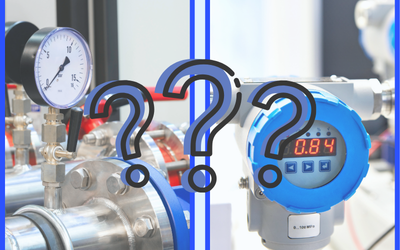Pressure measurement is fundamental in numerous applications, from pressure-sensitive fluid level monitoring to optimal heating, ventilation, and air-conditioning systems operation. Pressure sensors are, therefore, ubiquitous and varied, with many types available on the market.

Image Credit: Superior Sensor Technology
Distinguishing between pressure sensors can be challenging. The widespread use of synonymous terminologies like transducer, sensor, and transmitter only compounds the issue and makes pressure sensor selection more difficult.
Absolute and gauge pressure sensors represent two reliable pressure sensor types. Their fundamental difference is their reference points, a basic distinction and a major determining factor in their performance in various settings.
Understanding these differences is vital for device integrators looking to measure and control pressure effectively across numerous applications.
Absolute Pressure Sensors
Reference Point
Absolute pressure sensors measure pressure relative to a perfect vacuum (or absolute zero pressure) and calculate the total force exerted by a gas or fluid against this fixed reference point, including atmospheric pressure.
These accurate pressure sensors remain unaffected by altitude changes or ambient pressure.
Applications
Absolute pressure sensors are suited to applications demanding consistent and precise pressure measurement, irrespective of external conditions. Absolute pressure sensors are routinely used in the following ways:
- Barometric pressure measurements to ensure accurate atmospheric pressure data in vital applications such as altimetry and weather forecasting.
- Leak testing to ensure the integrity of sealed systems in industrial applications by detecting even slight pressure changes over long periods.
- Engine performance testing to measure actual pressure value—essential in optimizing engine performance in the automotive and aerospace industries.
Units of Measurement
Absolute pressure sensors measure pressure in units like pounds per square inch absolute, highlighting that pressure is measured from an absolute vacuum point. They are especially suitable for high-pressure environments where accurate, stable pressure readings are essential.
Gauge Pressure Sensors
Reference Point
Gauge pressure sensors measure pressure relative to the current atmospheric pressure. As their reference point is the surrounding air pressure, this sensor is sensitive to changes in environmental conditions, such as altitude or weather.
Applications
Gauge pressure sensors are vital in applications where it is necessary to determine pressure relative to ambient pressure. They are regularly used in:
- Hydraulic systems, where it is necessary to maintain and control the system’s pressure relative to atmospheric conditions to ensure safety and efficiency.
- Vacuum systems, where accurate pressure sensing relative to the surrounding atmosphere is vital for industries like semiconductor manufacturing.
- Tire pressure monitoring, where the sensors measure the pressure relative to atmospheric pressure to maintain vehicle safety in automotive applications.
Units of Measurement
Pressure readings from gauge pressure sensors are generally expressed in pounds per square inch gauge, illustrating that the pressure measurement has been acquired relative to atmospheric pressure. Gauge pressure sensors are suitable for many general-purpose pressure transducers.
Key Differences Between Absolute and Gauge Pressure Sensors
Environmental Sensitivity
Absolute pressure sensors deliver consistent readings regardless of environmental changes and are ideal for applications where accurate long-term pressure measurement is essential.
Gauge pressure sensors are contrastingly directly affected by atmospheric conditions, impacting their accuracy in environments with regularly changing conditions.
Measurement Context
Using absolute pressure sensors is advisable when accurately measuring actual pressure value—independent of external factors—is essential.
Gauge pressure sensors provide the necessary insight in applications where pressure relative to the surrounding atmosphere is considered a more relevant measurement. They may be more useful in industrial applications where air pressure varies.
Selecting the Right Sensor
Choosing the most appropriate sensor for an application depends on its specific needs. Some settings require the stable accuracy of an absolute pressure sensor for high-pressure measurements, while others will benefit from the contextual awareness provided by a gauge pressure sensor.
Understanding these differences is vital, and device integrators must consider factors such as pressure range, environmental conditions, and required digital output when choosing between these pressure sensors.
Acknowledgments
Produced from materials originally authored by Superior Sensor Technologies.

This information has been sourced, reviewed, and adapted from materials provided by Superior Sensor Technology.
For more information on this source, please visit Superior Sensor Technology.